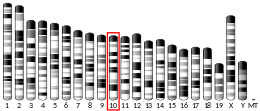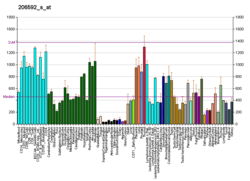AP3D1
AP-3 complex subunit delta-1 is a protein that in humans is encoded by the AP3D1 gene.[5][6][7]
Function
AP3D1 is a subunit of the AP3 adaptor-like complex, which is not associated with clathrin. The AP3D1 subunit is implicated in intracellular biogenesis and trafficking of pigment granules and possibly platelet dense granules and neurotransmitter vesicles.[supplied by OMIM][7]
Interactions
AP3D1 has been shown to interact with SYBL1.[8]
gollark: Yes. People often ask "how do I do [some crypto operation]" so just point them to it.
gollark: Well, we could probably convince people to use it quite easily.
gollark: Supporting common stuff like hashing, maybe a more secure (P)RNG, and symmetric/asymmetric encryption.
gollark: Also, we could really use a unified CC crypto library instead of every program randomly pulling in their own possibly broken versions.
gollark: No, there are two password systems which work incompatibly.
References
- GRCh38: Ensembl release 89: ENSG00000065000 - Ensembl, May 2017
- GRCm38: Ensembl release 89: ENSMUSG00000020198 - Ensembl, May 2017
- "Human PubMed Reference:". National Center for Biotechnology Information, U.S. National Library of Medicine.
- "Mouse PubMed Reference:". National Center for Biotechnology Information, U.S. National Library of Medicine.
- Simpson F, Peden AA, Christopoulou L, Robinson MS (May 1997). "Characterization of the adaptor-related protein complex, AP-3". The Journal of Cell Biology. 137 (4): 835–45. doi:10.1083/jcb.137.4.835. PMC 2139840. PMID 9151686.
- Ooi CE, Moreira JE, Dell'Angelica EC, Poy G, Wassarman DA, Bonifacino JS (Aug 1997). "Altered expression of a novel adaptin leads to defective pigment granule biogenesis in the Drosophila eye color mutant garnet". The EMBO Journal. 16 (15): 4508–18. doi:10.1093/emboj/16.15.4508. PMC 1170077. PMID 9303295.
- "Entrez Gene: AP3D1 adaptor-related protein complex 3, delta 1 subunit".
- Martinez-Arca S, Rudge R, Vacca M, Raposo G, Camonis J, Proux-Gillardeaux V, Daviet L, Formstecher E, Hamburger A, Filippini F, D'Esposito M, Galli T (Jul 2003). "A dual mechanism controlling the localization and function of exocytic v-SNAREs". Proceedings of the National Academy of Sciences of the United States of America. 100 (15): 9011–6. doi:10.1073/pnas.1431910100. PMC 166429. PMID 12853575.
External links
- Human AP3D1 genome location and AP3D1 gene details page in the UCSC Genome Browser.
Further reading
- Höning S, Sandoval IV, von Figura K (Aug 1998). "A di-leucine-based motif in the cytoplasmic tail of LIMP-II and tyrosinase mediates selective binding of AP-3". The EMBO Journal. 17 (5): 1304–14. doi:10.1093/emboj/17.5.1304. PMC 1170479. PMID 9482728.
- Kantheti P, Qiao X, Diaz ME, Peden AA, Meyer GE, Carskadon SL, Kapfhamer D, Sufalko D, Robinson MS, Noebels JL, Burmeister M (Jul 1998). "Mutation in AP-3 delta in the mocha mouse links endosomal transport to storage deficiency in platelets, melanosomes, and synaptic vesicles". Neuron. 21 (1): 111–22. doi:10.1016/S0896-6273(00)80519-X. PMID 9697856.
- Rehling P, Darsow T, Katzmann DJ, Emr SD (2000). "Formation of AP-3 transport intermediates requires Vps41 function". Nature Cell Biology. 1 (6): 346–53. doi:10.1038/14037. PMID 10559961.
- Craig HM, Reddy TR, Riggs NL, Dao PP, Guatelli JC (May 2000). "Interactions of HIV-1 nef with the mu subunits of adaptor protein complexes 1, 2, and 3: role of the dileucine-based sorting motif". Virology. 271 (1): 9–17. doi:10.1006/viro.2000.0277. PMID 10814565.
- Crump CM, Xiang Y, Thomas L, Gu F, Austin C, Tooze SA, Thomas G (May 2001). "PACS-1 binding to adaptors is required for acidic cluster motif-mediated protein traffic". The EMBO Journal. 20 (9): 2191–201. doi:10.1093/emboj/20.9.2191. PMC 125242. PMID 11331585.
- Austin C, Boehm M, Tooze SA (Apr 2002). "Site-specific cross-linking reveals a differential direct interaction of class 1, 2, and 3 ADP-ribosylation factors with adaptor protein complexes 1 and 3". Biochemistry. 41 (14): 4669–77. doi:10.1021/bi016064j. PMID 11926829.
- Janvier K, Craig H, Hitchin D, Madrid R, Sol-Foulon N, Renault L, Cherfils J, Cassel D, Benichou S, Guatelli J (Mar 2003). "HIV-1 Nef stabilizes the association of adaptor protein complexes with membranes". The Journal of Biological Chemistry. 278 (10): 8725–32. doi:10.1074/jbc.M210115200. PMID 12486136.
- Nie Z, Boehm M, Boja ES, Vass WC, Bonifacino JS, Fales HM, Randazzo PA (Sep 2003). "Specific regulation of the adaptor protein complex AP-3 by the Arf GAP AGAP1". Developmental Cell. 5 (3): 513–21. doi:10.1016/S1534-5807(03)00234-X. PMID 12967569.
- Salazar G, Love R, Werner E, Doucette MM, Cheng S, Levey A, Faundez V (Feb 2004). "The zinc transporter ZnT3 interacts with AP-3 and it is preferentially targeted to a distinct synaptic vesicle subpopulation". Molecular Biology of the Cell. 15 (2): 575–87. doi:10.1091/mbc.E03-06-0401. PMC 329249. PMID 14657250.
- Lefrançois S, Janvier K, Boehm M, Ooi CE, Bonifacino JS (Oct 2004). "An ear-core interaction regulates the recruitment of the AP-3 complex to membranes". Developmental Cell. 7 (4): 619–25. doi:10.1016/j.devcel.2004.08.009. PMID 15469849.
- Coleman SH, Van Damme N, Day JR, Noviello CM, Hitchin D, Madrid R, Benichou S, Guatelli JC (Feb 2005). "Leucine-specific, functional interactions between human immunodeficiency virus type 1 Nef and adaptor protein complexes". Journal of Virology. 79 (4): 2066–78. doi:10.1128/JVI.79.4.2066-2078.2005. PMC 546596. PMID 15681409.
- Dong X, Li H, Derdowski A, Ding L, Burnett A, Chen X, Peters TR, Dermody TS, Woodruff E, Wang JJ, Spearman P (Mar 2005). "AP-3 directs the intracellular trafficking of HIV-1 Gag and plays a key role in particle assembly". Cell. 120 (5): 663–74. doi:10.1016/j.cell.2004.12.023. PMID 15766529.
- Theos AC, Tenza D, Martina JA, Hurbain I, Peden AA, Sviderskaya EV, Stewart A, Robinson MS, Bennett DC, Cutler DF, Bonifacino JS, Marks MS, Raposo G (2006). "Functions of adaptor protein (AP)-3 and AP-1 in tyrosinase sorting from endosomes to melanosomes". Molecular Biology of the Cell. 16 (11): 5356–72. doi:10.1091/mbc.E05-07-0626. PMC 1266432. PMID 16162817.
This article is issued from Wikipedia. The text is licensed under Creative Commons - Attribution - Sharealike. Additional terms may apply for the media files.






